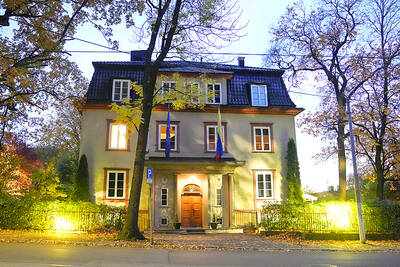Neanderthals and modern humans interbred, probably when early humans first began to migrate out of Africa, according to a genetic study released on Thursday.
People of European, Asian and Australasian origin all have Neanderthal DNA, but not Africans, researchers reported in yesterday’s issue of the journal Science.
The study may help resolve the long-running debate over whether Neanderthals and modern humans did more than simply live side by side in Europe and the Middle East.
“Those of us who live outside Africa carry a little Neanderthal DNA in us,” said Svante Paabo of the Max Planck Institute in Munich, Germany, who led the study.
“The proportion of Neanderthal-inherited genetic material is about 1 to 4 percent. It is a small but very real proportion of ancestry in non-Africans today,” David Reich of Harvard Medical School in Boston, who worked on the study, told reporters in a telephone briefing.
While the findings may lead to jokes about cave-man behavior or looks, Paabo said his team cannot identify any Neanderthal “traits.”
“As far as we can tell these are just random pieces of DNA,” he said.
The researchers used modern methods called whole genome sequencing to examine the DNA from Neanderthal bones found in Croatia, Russia, Germany and Spain, including some crushed leg bones from one Croatian cave that some scientists believe are evidence of cannibalism.
The researchers developed new methods to gather, distinguish and sequence the Neanderthal DNA.
“In those bones that are 30,000, 40,000 years old there is of course very little DNA preserved,” Paabo said.
He said 97 percent or more of the DNA extracted was from bacteria and fungi.
They compared the Neanderthal sequences with DNA sequences from five people from Europe, Asia, Papua New Guinea and Africa.
“Their analysis shows the power of comparative genomics and brings new insights to our understanding of human evolution,” Eric Green, director of the National Human Genome Research Institute at the National Institutes of Health, said in a statement.
The results add to a picture of modern humans living alongside with and interacting on the most intimate levels with similar humans who have now gone extinct.
“It certainly is an indication of what went on socially when Neanderthals and modern humans met,” Paabo said.
“There was interbreeding at some little level. I would prefer to leave it to others who want to quarrel over whether to call us separate species or not,” he said. “They were not genetically very distinct from us.”
The DNA sequences date back to somewhere around 80,000 years ago, when modern humans moving through the Middle East on their way out of Africa would have encountered Neanderthal populations.
The researchers identified five genes unique to Neanderthals, including three skin genes.
“This suggests that something in the physiology or morphology of the skin has changed in humans,” Paabo said.
In March Paabo and colleagues reported they had found a previously unknown human species that lived 30,000 years ago alongside modern humans and Neanderthals in Siberia.
Scientists have speculated that different species of humans lived side by side at various times over the past million years. But many would have lived in tropical zones where bones are not easily preserved.
Paabo said modern-day Africans may carry some of that unknown DNA even if they do not have Neanderthal ancestors.

The Venezuelan government on Monday said that it would close its embassies in Norway and Australia, and open new ones in Burkina Faso and Zimbabwe in a restructuring of its foreign service, after weeks of growing tensions with the US. The closures are part of the “strategic reassignation of resources,” Venezueland President Nicolas Maduro’s government said in a statement, adding that consular services to Venezuelans in Norway and Australia would be provided by diplomatic missions, with details to be shared in the coming days. The Norwegian Ministry of Foreign Affairs said that it had received notice of the embassy closure, but no

A missing fingertip offers a clue to Mako Nishimura’s criminal past as one of Japan’s few female yakuza, but after clawing her way out of the underworld, she now spends her days helping other retired gangsters reintegrate into society. The multibillion-dollar yakuza organized crime network has long ruled over Japan’s drug rings, illicit gambling dens and sex trade. In the past few years, the empire has started to crumble as members have dwindled and laws targeting mafia are tightened. An intensifying police crackdown has shrunk yakuza forces nationwide, with their numbers dipping below 20,000 last year for the first time since records

EXTRADITION FEARS: The legislative changes come five years after a treaty was suspended in response to the territory’s crackdown on democracy advocates Exiled Hong Kong dissidents said they fear UK government plans to restart some extraditions with the territory could put them in greater danger, adding that Hong Kong authorities would use any pretext to pursue them. An amendment to UK extradition laws was passed on Tuesday. It came more than five years after the UK and several other countries suspended extradition treaties with Hong Kong in response to a government crackdown on the democracy movement and its imposition of a National Security Law. The British Home Office said that the suspension of the treaty made all extraditions with Hong Kong impossible “even if

Former Japanese prime minister Tomiichi Murayama, best known for making a statement apologizing over World War II, died yesterday aged 101, officials said. Murayama in 1995 expressed “deep remorse” over the country’s atrocities in Asia. The statement became a benchmark for Tokyo’s subsequent apologies over World War II. “Tomiichi Murayama, the father of Japanese politics, passed away today at 11:28am at a hospital in Oita City at the age of 101,” Social Democratic Party Chairwoman Mizuho Fukushima said. Party Secretary-General Hiroyuki Takano said he had been informed that the former prime minister died of old age. In the landmark statement in August 1995, Murayama said